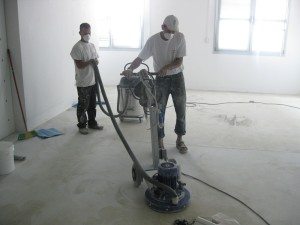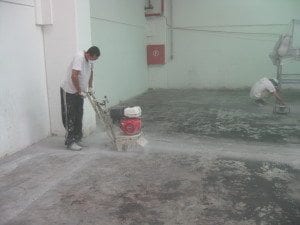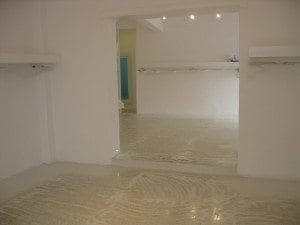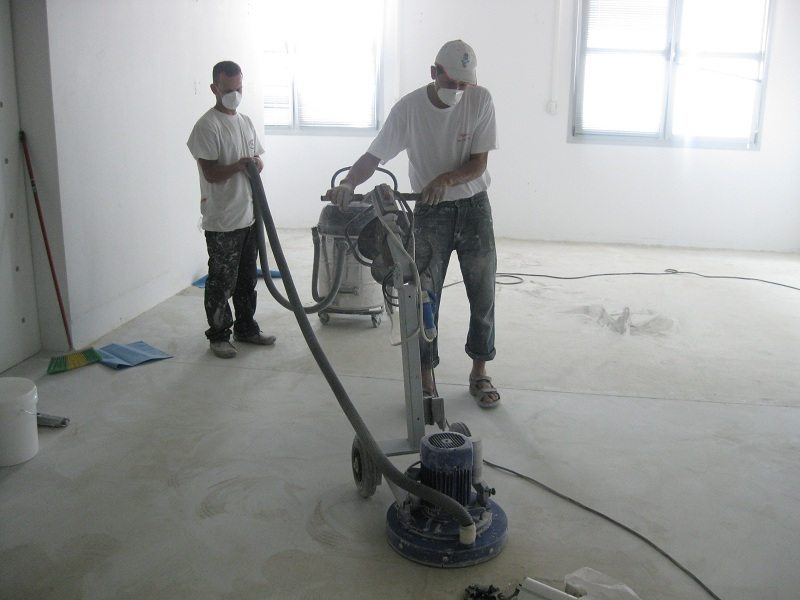What are the most commonly used methods?
Surface preparation is the single most important stage when executing an epoxy flooring project. Poor surface preparation can lead to significant problems such as the coating cracking, or detaching itself from the substrate. These problems may not appear straight away, but could show up after a few months. The purpose of surface preparation is to therefore prevent such problems from occurring by a) cleaning the surface from dirt, oils, old coatings, or any other residue that could pose problems for the bonding of the substrate to the coating b) mechanically treating the surface by scraping or roughening. This will enable better bonding of the primer to the substrate.
Surface preparation can be carried out either mechanically (with the use of equipment) or chemically, or both. We take a look at the main methods below:
Diamond grinding – Diamond grinders are gaining rapidly in popularity as they are very versatile in their use. The large choice of diamond tools available makes it possible for a contractor to manage all types of surfaces. They are very useful for cleaning surfaces that have accumulated dirt and been contaminated with various substances. As cement substrates can differ greatly in hardness and quality, it is advisable to pick a diamond tool that can handle the type of surface in question. Diamond tools can also be used to remove old coatings.
The large choice of diamond tools available makes it possible for a contractor to manage all types of surfaces. They are very useful for cleaning surfaces that have accumulated dirt and been contaminated with various substances. As cement substrates can differ greatly in hardness and quality, it is advisable to pick a diamond tool that can handle the type of surface in question. Diamond tools can also be used to remove old coatings.
 Shot blasting and scarifying are somewhat rougher methods for surface preparation. These procedures are recommended if you are planning to install a thick coat (at least 4mm (1/8”) Shot-blasting and scarifying will leave a rather uneven surface with the dents in the surface exceeding 1-2mm. Therefore such surface prep methods are not recommended if you planning to install a thin coat, since the coating finish may seem rough and uneven.
Shot blasting and scarifying are somewhat rougher methods for surface preparation. These procedures are recommended if you are planning to install a thick coat (at least 4mm (1/8”) Shot-blasting and scarifying will leave a rather uneven surface with the dents in the surface exceeding 1-2mm. Therefore such surface prep methods are not recommended if you planning to install a thin coat, since the coating finish may seem rough and uneven.
Sanding of the surface (either with a handheld angle grinder or with a floor sanding machine) is considered a rather light form of surface preparation. It is a convenient method for prepping a surface if you plan on adding an additional coat on top of an existing coat, or if you need to even out small anomalies in the surface.
Chemical treatment of the surface is recommended if you need to clean a heavily contaminated surface from  oils or other chemicals. The chemical detergents will penetrate the surface and will bring out any residue that has been absorbed by the substrate. This process may need to be repeated several times until all waste has been removed. Any use of chemical cleaners should be done with caution and should by tried out on a small surface first before applying full-scale.
oils or other chemicals. The chemical detergents will penetrate the surface and will bring out any residue that has been absorbed by the substrate. This process may need to be repeated several times until all waste has been removed. Any use of chemical cleaners should be done with caution and should by tried out on a small surface first before applying full-scale.
Concluding, there is no one correct method to prepare a floor surface. It is a matter of assessing all the various factors that come into play and determining the right course of action.
Akis Apostolopoulos


Shot blasting is what My friend’s company uses for laying thick epoxy on floors of Kidney Dialysis Centers, followed by a clearish rubbery membrane and several coats of Epoxy sometimes with sand in between coats. I’ve worked a few jobs with him. It’s a lot of work.